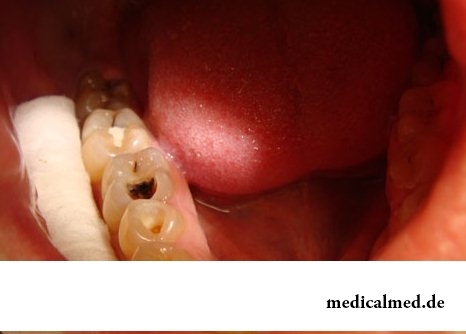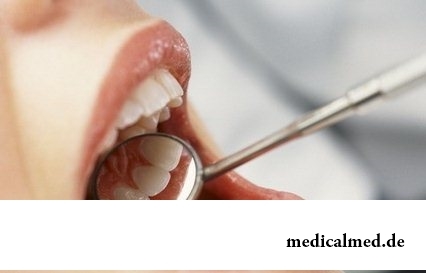





Caries dentium - a disease of millions

Caries – destruction of teeth which has the localized and progressing character. Caries begins organic acids of an inorganic basis of an adamantine substance of tooth with destruction. Demineralization process is inevitably followed by organic destruction of tooth with the subsequent formation of a cavity and infection. More than 95% of people long caries in this or that stage for statistical data.
The susceptibility of a tooth surface to caries depends on a large number of factors:
- geneticists, i.e. heredities;
- the general state of health;
- preventive and hygienic actions of an oral cavity;
- healthy, balanced nutrition;
- anatomic features of a tooth surface. In intervals and deepenings of teeth favorable conditions for education and fixing of a plaque are created;
- saturations of enamel of teeth fluorine. Normal indicators of maintenance of this element does an adamantine substance of tooth steadier against influence of acids;
- quantities and quality of saliva, its buffer properties on acid neutralization.
Main reasons for caries of teeth
Stomatologists of the whole world allocate the following reasons of caries:
- Unsatisfactory hygienic condition of an oral cavity;
- Weakening of immune system of an organism in general and existence of chronic diseases of an organism. The infectious diseases (tuberculosis or rickets) postponed in the childhood which broke process of formation of tooth fabrics;
- Genetic predisposition of the person to caries. She in many respects explains caries at children;
- The drinking water containing the lowered or increased content of phosphorus, fluorine, calcium, etc.
- Diet. The lack of vitamins and minerals, lack of norm in the ratio of proteins and carbohydrates, decrease in a diet of products of a natural origin, abundance of food with the high content of sugar, etc. provoke emergence of this disease;
- Geographical features of the area and social factors (for example, work on harmful productions).
The reasons of caries of teeth do not influence one by one an onset of the illness and development of caries. It is system process which consists of a set of factors.
Caries stages
Caries as the progressing disease, has several stages of development. Let's shortly consider the main stages of caries:
- Initial – macula cariosa (a spot stage) when demineralization begins with the fact that natural gloss of an adamantine substance of tooth leaves and appear gray or light--, dark brown specks. Caries, as a rule, passes in this stage asymptomatically.
- Superficial (caries superficialis) and average (caries media) caries can be combined in one stage of which emergence of destructive changes of an adamantine substance of tooth on places of spots is characteristic. The main symptom of a disease at this stage – developing of short-term pains on temperature and chemical irritants (cold, hot, acid, salty). At the same time, the cavity (defect) with only that difference is formed that at superficial caries – in enamel, and at an average already in tooth tissue (dentine).
- caries profunda stage – deep caries – is characterized by existence of a deep carious cavity, painful feelings at temperature, mechanical and chemical influences. In some cases there are signs of an inflammation of a neurovascular bunch (pulpitis).
It is possible to carry cervical caries to a special kind of caries – the name corresponds to the place of developing of caries on tooth, in a tooth neck at the gingiva. Cervical caries arises and develops in this place of tooth thanks to a weak layer of enamel in a neck and inaccessibility of this place at the procedure of care of teeth.
Process of developing of caries takes place slowly therefore it is visually easy for adult to find it and in order that development of caries had no continuation, it is necessary to address the stomatologist at once. Caries at children arises with the same symptoms, as at adults therefore parents are obliged to check periodically dental health of the kid (even milk), and at emergence of the first visible symptoms of caries of a message of the child to the doctor. In this case development of caries in the child will be stopped.
Diagnosis of caries
Diagnosis of caries is possible only if you regularly visit the stomatologist. Deep caries is diagnosed without difficulties – visually. Diagnosis of caries at early stages is made by means of roentgenograms and a thermodiagnostic.
Diagnosis of initial caries is carried out by the transluminescences method, i.e. tooth raying from a reverse side a strong ray of light. Early diagnosis of caries allows the doctor to carry out treatment in time and to stop development of caries.
Treatment of caries

At an initial stage treatment of caries is carried out by method of remineralizing therapy (application) with preliminary cleaning of tooth of a plaque.
Treatment of caries of superficial, average and deep stages is carried out by method of removal of the struck fabric. Then sealing of a carious cavity is made. It is necessary to remember that earlier treatment of caries sealing allows to keep tooth in a healthy state longer.
If not to carry out treatment of caries in time, then caries can get more severe form, for example, to pass into periodontitis or a pulpitis, with the subsequent loss of tooth.
Prevention of caries
Prevention of caries much more reduces risk of developing of a disease. Especially important to parents to control holding preventive actions. Caries at children, especially small age is "merit" of parents who did not react to visible changes of teeth or to complaints of the child in time.
Enters preventive actions:
- Hygienic prevention of caries is a care of all oral cavity, use of fluorinated pastes, use of solutions or pastes with hlorgeksidiny, the xylitol use (chewing gums);
- Medical prevention is the general improvement of an organism, elimination of deformations of teeth, holding certain actions, for example, sealing (closing) of fissures and blind "poles" in which the plaque can be formed;
- Systematic visit of the stomatologist.
Stomatologists appeared relatively recently. In the 19th century to pull out painful teeth belonged to duties of the ordinary hairdresser.

There is a lot of fans of beer in our country. Statistically, on each average Russian (including women and children) in...
Section: Articles about health
One of the major chemical processes happening in a human body are oxidation reactions. They go with participation of fats and carbohydrates which we receive from food, and the oxygen getting to us from air. A main goal of such reactions is it is received...
Section: Articles about health
Diseases of joints often begin imperceptibly for the person. The first stages of destruction of the cartilaginous tissue providing soft and free sliding of heads of bones in joint bags proceed slowly and absolutely without serious consequences. Especially unpleasantly for the fact that this process is not connected with advanced age: degradation of joint surfaces is, as a rule, noticeable after 30 years. It means that practically each able-bodied person at any time can face sad results...
Section: Articles about health
Kidneys perform the most important function of clarification of blood from those products of metabolic processes which cannot be used орг...
Section: Articles about health
Each failure in work of bodies and systems of a human body is, as a rule, shown by the whole complex of symptoms. In particular, malfunctions with health often cause emergence of cosmetic defects in the form of rashes on a face. Experienced doctors know that локализац...
Section: Articles about health
For the time being the perspective of heart diseases seems to most of people remote and foggy. But sooner or later practically each adult faces extremely unpleasant feelings: sudden stethalgia. To be consoled at this time in a thought of what for a heart attack still early, will hardly turn out: if the person is impressionable, he, as a rule, has feeling of panic and fear of fast death. And meanwhile, it is very often possible to confuse pains with cardiac pains невралгическог...
Section: Articles about health
"Epilepsy" doctors made the diagnosis in antique times. Displays of an illness and pattern of its development are very well studied. Odes...
Section: Articles about health
Statistically cystitis 25-30% of women up to 40 years have. With age this indicator raises, besides many do not get to statistics because do not see a doctor. The most sad that after the regular visits to doctors, long reception of antibiotics...
Section: Articles about health
For the help to doctors in the choice of optimal solutions for treatment of various diseases the Cochrane scientific organization (Cochrane) conducts joint researches with representatives of scientific community around the world. The analysis of a series of the conducted researches of the drug Oscillococcinum® relating to group of cold remedies became one of the last methanolyses....
Section: Articles about health
It is known that the person for 80% consists of water which participates in all processes of an organism. The person loses liquid daily – in...
Section: Articles about health
Cold – a state known to everyone which is followed by cold, cough, high temperature, a pharyngalgia. Often the first that we begin to do in hope again to become healthy – to accept medicines which are not always harmless, then...
Section: Articles about health
Almost each of us during life faced dissatisfaction with own body. At such moments, as a rule, we begin to shame ourselves, urgently we go on the most rigid diet promising minus of 10 kg in a week, or we exhaust ourselves in the gym to almost death. As a rule, similar attempts come to an end with a campaign to the refrigerator for jamming of the next stress. Further history repeats itself with individual frequency....
Section: Articles about health
Each person has easy indispositions which he transfers "standing", trying not to ask for medical care. Argu...
Section: Articles about health
Doctors claim that the people not so familiar with a dorsodynia occur among adult Russians very seldom. At the same time the vast majority of the patients who are periodically testing this indisposition do not hurry to ask for medical care at all. With one St...
Section: Articles about health
Since the moment when the child becomes a school student, his sight begins to be exposed to the strengthened loadings which are supplemented with viewing of animated films and long computer games. During this period of life of the child development of not completely created organs of sight, it is very easy to break the excessive loading which is aggravated with lack of a work-rest schedule. As a rule, and occurs: according to WHO statistics, every fourth child of school age has these or those diseases of eyes, Wednesday...
Section: Articles about health
The next flu epidemic leads to the next panic, from year to year we give in on these manipulations: professionally alarming goal...
Section: Articles about health
Zone hypostases under eyes - very widespread problem giving to people is a lot of inconvenience. Hypodermic fabric in these parts has very loose structure and almost does not contain collagenic fibers. Besides, the skin covering подглазья constantly is exposed...
Section: Articles about health
Tick-borne encephalitis – one of the most dangerous viral diseases which causative agents transfer and is given to people by ixodic mites. These are the small blood-sicking insects living in the considerable territory of our country. The person bitten by a tick can catch also erlikhiozy, bartonnelezy, babeziozy, mycoplasmosis and Lyme's disease. As well as encephalitis, these illnesses affect the central nervous system, and as specific antiviral therapy does not exist, the forecast very to a neuta...
Section: Articles about health
About 10-15 years ago existence of the computer in the apartment of the Russian was considered as a rarity and office rooms were only on перв...
Section: Articles about health
So, you resolved to lose weight. And now you try to understand what to begin with: from exercise stresses or a diet? And how to make that process of weight loss did not give you an inconvenience, and, on the contrary, brought joy?...
Section: Slideshow
The state of health of the person in many respects depends on chemical composition of biological liquids of an organism. Specialists consider that PH value of these solutions has to be in range of 7,35-7, 45. The deviation in the smaller party (so-called "acidulation") is fraught with development of many heavy illnesses, failures in work of immune system, decrease in working capacity and deterioration of life. To avoid serious fluctuations of acidity of internal liquids it is necessary to adhere разумног...
Section: Articles about health
Today about 30 diseases, sexually transmitted are known. To wide circulation of these illnesses extremely with...
Section: Articles about health
Partial and the more so full loss of hearing significantly reduces quality of life. Difficulties with communication lead to loneliness and isolation. The person who badly hears experiences difficulties with social and professional implementation, quite often has problems in...
Section: Articles about health
High temperature - a frequent symptom of such widespread diseases as a SARS, quinsy, pneumonia, etc. To reduce heat, having facilitated a condition of the patient, doctors recommend to accept antipyretics, however their use is not always possible. Too frequent use of these drugs can lead to allergic reactions, and also overdose, causing poisoning. It happens also that there are no antipyretics simply in the house. In these situations it is pertinent to use it...
Section: Articles about health
About 20% of the population of our planet have a hypertension (permanent increase in arterial pressure). This disease negatively narrations...
Section: Articles about health
Each woman has preferences in the field of use of those goods which help us to look good, feel young and effective. Besides: selection process of favourite perfume, shampoo or decorative cosmetics already lifts a spirit...
Section: Articles about health
Long time antibiotics were considered as a panacea from all diseases and were appointed even at insignificant symptoms of an infection. Even now not everyone knows in what force of antibiotics how and when they should be accepted. Let's discredit 7 popular myths about such drugs....
Section: Articles about health
